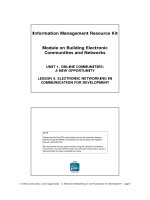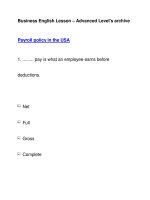btec level 4 hnd diploma in business unit 5 accounting principles 5038
Bạn đang xem bản rút gọn của tài liệu. Xem và tải ngay bản đầy đủ của tài liệu tại đây (1.86 MB, 44 trang )
<span class="text_page_counter">Trang 1</span><div class="page_container" data-page="1">
<b> ASSIGNMENT 1 FRONT SHEET</b>
<b>QualificationBTEC Level 4 HND Diploma in BusinessUnit number and titleUnit 5: Accounting Principles (5038)</b>
</div><span class="text_page_counter">Trang 3</span><div class="page_container" data-page="3"><b>Summative Feedbacks: Resubmission Feedbacks:</b>
<b>Internal Verifier’s Comments:</b>
</div><span class="text_page_counter">Trang 4</span><div class="page_container" data-page="4"><b>Signature & Date:</b>
</div><span class="text_page_counter">Trang 5</span><div class="page_container" data-page="5">Welcome to the blog "The Role of an Accountant in an Organization" I recently joined the company asan Intern, working with their SME Units, providing Accounting Services services and finance forbusinesses that usually have revenue from 10 billion VND to 100 billion VND. As part of the training, Iwas asked to do a number of activities. My supervisor, one of the company's Principal Directors,asked me to prepare a blog for the purpose of marketing and promoting the company's accountingservices. A large accounting firm undertakes extensive business consulting for its clients. My companyis headquartered in central London and has UK branch offices in Birmingham and Southampton. Lastyear, group revenues were £200m with 25% coming from markets outside the UK, mainly in SouthEast Asia. My company has a small branch office in Vietnam. The company also has a policy ofattracting corporate customers to smaller businesses that they feel have the potential to growquickly. This blog is divided into two parts: The first part provides a more in-depth explanation of anorganization's accounting function, including the definition and purpose of the organization and themain users of accounting information. For example, evaluate the interdependencies betweenaccounting and other organizational tasks. The second part discusses the context and purposes offinancial accounting and management accounting, including the role and relevance of accounting, thedifferences between financial accounting and management accounting, and finally same is. alongwith organizational constraints and threats in the accounting field.The role of accountants
<b>1. Defined of accounting</b>
</div><span class="text_page_counter">Trang 6</span><div class="page_container" data-page="6">According to Clause 8, Article 3 of the Law on Accounting 2015, “Accounting is the collection, processing,examination, analysis and provision of economic and financial information in the form of value, in kindand labor time. moving".
In simple terms, accounting is the work of recording and processing all financial-related information of anenterprise, thereby providing financial information for business performance evaluation. basis foreconomic decisions. (Huong, 2021)
</div><span class="text_page_counter">Trang 7</span><div class="page_container" data-page="7">Accounting is the process of identifying, measuring, and communicating financial informationinformation about an entity to enable informed judgments and decisions by users information. (Financialand Management Accounting An introduction - Pauline Weetman)
Accounting is concerned with collecting, analysing and communicating financial information. Theultimate aim is to help those using this information to make more informed decisions. Unless thefinancial informa- tion being communicated can lead to better decisions being made, there really is nopoint in producing it. We shall see who uses financial information and for what kind of decisions it isuseful a little later in the chapter.
Sometimes the impression is given that the purpose of accounting is simply to prepare financial(accounting) reports on a regular basis. While it is true that accountants undertake this kind of work, itdoes not represent an end in itself. These reports are prepared for a reason. As already mentioned, theultimate aim of the accountant’s work is to give users financial information to improve the quality of theirdecisions. This decision-making per- spective of accounting provides the theme for this book and shapesthe way in which we deal with each topic.( PETER MCLANEY EDDIE ATRILL - Accounting and finance fornon-specialists-PEARSON EDUCATION Limited (2018)
<b>2. The role of accounting</b>
The purpose of accounting is to summarize and report financial information about performance, financialposition and cash flow of a business. This information is then used to make decisions about how tomanage a business, invest in it or lend money to it (Atrill and MacLaney, 2018)
</div><span class="text_page_counter">Trang 8</span><div class="page_container" data-page="8">- The accounting department helps the business operate smoothly. Businesses only exist when economictransactions occur and cash flows circulate. Arising transactions will be promptly processed and recordedby Accounting.
- Helps manage and control business finances, limiting risks of internal fraud.
- The Accounting department helps managers monitor the business performance of the enterprise fromrevenue and incurred costs; Detect financial abnormalities from past transactions and at the same timebe able to make appropriate assessments and business plans for the future.
</div><span class="text_page_counter">Trang 9</span><div class="page_container" data-page="9">- Accounting documents are an important basis and evidence when businesses have commerciallitigation disputes.
- Accountants comply with regulations on accounting and tax regimes to help businesses limit the risks ofadministrative violations against State regulations on Accounting and Taxation.
- Accounting helps businesses limit tax risks. Help businesses optimize taxes but ensure compliance withthe law.
- Help businesses update tax policies and accounting regimes, as well as promptly update State supportpolicies such as preferential bank loan interest rates and tax incentive policies.
<b>3. Types of accounting</b>
Accounting is divided into two main categories: financial accounting and management accounting. Thereare also some other types of accounting such as tax accounting, cost accounting, public accounting...Financial accounting: It is the collection and processing of test, analyze and provide business informationeconomic, financial by reporting finance for those who have demand accounting information. (Fernando,2023)
Management accounting: It is the collection and processing of test, analyze and supply provide economicand financial information according to administrative requirements and decisions economic and financialregulations in within the accounting unit. (Fernando, 2023)
</div><span class="text_page_counter">Trang 11</span><div class="page_container" data-page="11">Tax Accountant: strategically plans the optimal business composition to minimize tax liabilities as well asensures compliance with tax reporting.
Managerial Accountant: analyzes financial transactions to make thoughtful, strategic recommendationsoften related to the manufacturing of goods.
Information and Technology Analyst/Accountant: maintains the system and software in which accountingrecords are processed and stored.
Controller: oversees the accounting functions of financial reporting, accounts payable, accountsreceivable, and procurement. (Fernando, 2023)
<b>Users of Accounting Information</b>
</div><span class="text_page_counter">Trang 12</span><div class="page_container" data-page="12">Figure 1: Main users of accounting informationInternal Users
Owers: Owners need to assess how well their business is performing. Financial statements provideinformation to owners about the profitability of the overall business as well as individual products andgeographic segments. Owners are also interested in knowing how risky their business is. Accountinginformation helps owners in assessing the level of stability in business over the years and to what extent
</div><span class="text_page_counter">Trang 13</span><div class="page_container" data-page="13">have changes in economic factors affected the bottom line of the business. Such information helpsowners to decide if they should invest any further in the business or if they should use their financialresources elsewhere in more promising business ventures.
Managers: need accounting information to plan, monitor, and make business decisions. In the case ofinvestment decisions, for example, managers would require the return on investment calculation of aproposed project supported by reliable estimates of the costs and revenues.
Officers: To review the operational situation and make the correct decision for the company.
Employees: For the employees operating in the finance department, using accounting information isusually part of their job description. This includes for example preparing and reviewing various financialreports such as financial statements. Employees are interested in knowing how well a company isperforming as it could have implications for their job security and income. Many employees reviewaccounting information in the annual report just to get a better understanding of the company’sbusiness. Moreover, potential employees are also interested to learn about the financial health of theorganization they aspire to join in the future. Other examples In addition, there are Sales Staff, BudgetOfficers, Controllers, Internal Auditors... (Atrill and MacLaney, 2018)
External Users
Shareholders of a company: Company’s shareholders are the real owners of a business and needsinformation from those that manage the business on their behalf.
</div><span class="text_page_counter">Trang 14</span><div class="page_container" data-page="14">Government: Government agencies want to know the financial condition and profits of a regulatedbusiness, which can impact the prices they will allow a firm to charge to its customers.
Lenders: The Lenders of a company need information concerning the financial position of a company.They need to be convinced that the company is liquid enough to meet with companym’s obligations uponmaturity.
Customers/ Consumer Groups: may also have either a short-term or long-term interest in the businessentity to know the profitability, liquidity, and solvency position of the business.
</div><span class="text_page_counter">Trang 15</span><div class="page_container" data-page="15">External auditors: The external auditors will sometimes need information about the finance of a companyto protect its interest.
Suppliers: Just like lenders, suppliers need accounting information to assess the creditworthiness of theircustomers before offering goods and services on credit. Some suppliers only have a handful of customers.These customers could be very large businesses themselves. Suppliers need accounting information oftheir key customers to assess whether their business is in good health which is necessary for sustainablebusiness growth.
Tax authorities: Tax authorities determine whether a business declared the correct amount of tax in itstax returns. Occasionally, tax authorities conduct audits of the tax returns filed by businesses to verify theinformation with the underlying accounting records. Tax authorities also cross-reference accountinginformation of suppliers and consumers to identify potential tax evaders. (Atrill and MacLaney, 2018)
<b>II.Context and purpose of financial accounting and management accounting1.The roles and importance of accounting as an information system</b>
</div><span class="text_page_counter">Trang 16</span><div class="page_container" data-page="16">Figure 2: Accounting information system
Accounting as an information system is responsible for identifying, recording, analyzing and reportinginformation to be used for decision making. It provides accurate data to managers before making anydecisions regarding the business. According to Atrill and McLaney (2018), there are four sequential stagesof an accounting information system:
• Identifying and capturing relevant information;
</div><span class="text_page_counter">Trang 17</span><div class="page_container" data-page="17">• Recording, in a systematic way, the information collected;• Analysing and interpreting the information collected; and• Reporting the information in a manner that suits users’ needs.
The main functions of an accounting information system include planning, control, and decision making.It is essential within the company as it allows managers to track income and expenditure, maintainregulatory compliance, and provide financial information to users. An effective accounting system is acritical component of a successful organization because when the accounting system fails or thecalculations are incorrect, the results can be detrimental to the company (Atrill and MacLaney, 2018).Qualitative characteristics include relevancy. Relevance is closely and directly related to the concept ofuseful information. Relevancy implies that all such items of information must be reported in order to beable to assist users in decision making. Next, reliability helps accounting information make decisions.Reliable information is needed to form judgments about the earnings potential and financial position of atrading company. Understandability is the quality of information that allows users to perceive itsimportance. Furthermore, when making a decision, the decision maker will compare alternatives, whichis
supported by financial information. Comparability implies having things like reported in a similar fashionand unlike other reported things. In addition, other qualities recommended by the IASB are materiality,truthful representation, quality over formality, neutrality, prudence, completeness, and timeliness (Kaur,2020).
</div><span class="text_page_counter">Trang 18</span><div class="page_container" data-page="18"><b>Distinguishing between financial accounting and management accounting</b>
The purpose Providing information to servethe management of productionand bussiness activities.
Provides information for thepreparation of financialstatements.
Scope <b>1. General Accounting: General Reporting performance and position</b>
</div><span class="text_page_counter">Trang 19</span><div class="page_container" data-page="19">accounting records external
<b>transactions covering cash receipts and payments, liabilities, and the </b>
setting up of <b>sales</b> and receivables. It also covers the preparation of regular financial
<b>statements</b> using <b>account</b> balances.
<b>2. Cost Accounting: Involves the </b>
application of the double-entry
<b>technique of internal transactions, </b>
which means the application of <b>costs</b> to jobs, operations, processes, and products. It helps sharpen the internal aspects of general accounting.
<b>3. Budgeting and Forecasting: This </b>
envisages the framing of budgets incooperation with other
departments, preferably using standard measures for amounts included in the budgets.
<b>4. Cost Control Procedures: These </b>
provide internal reports that compare actual and desired performance. Cost control procedures also help to convert a budget into an operating plan.
Reporting the performance of an organisation as well as the state of the organisation are the primary purposes. This can be seen through alternate names for the income statement and balance that were mooted for them namely the statement of financial performance and the statement of financial position.Reporting is not limited to direct stakeholders such as shareholders, there are many who are indirect or remote stakeholders of public and private companies who rely on the information provided by financial accounting. Therefore the scope of financial accounting has evolved over the years to accommodate these various user groups in the information published in the financial statements.
<b>Reporting to shareholders</b>
Shareholders invest their money, directly or indirectly and appoint a board of directors which in turn works
</div><span class="text_page_counter">Trang 20</span><div class="page_container" data-page="20"><b>5. Cost and Statistics: It is </b>
concerned with the provision of statistical and analytical services to the organization's departments.
<b>6. Taxation: This requires the </b>
calculation of <b>income</b> according to income tax laws and regulations, the filing of returns, and making taxpayments on or before a specific date.
with management and employees to run the business for the benefit of shareholders.Shareholders therefore rely on financial reporting to inform them of how well their resources are being managed by those they have appointed to do so. Therefore the scope of financial accounting information must be such that it gives an overview of the
</div><span class="text_page_counter">Trang 21</span><div class="page_container" data-page="21"><b>7. Methods and Procedures: These </b>
deal with reducing costs and improving the efficiency of <b>accounting</b> and office operations, including the preparation and issuance of accounting and other manuals where they will prove useful.
entire business in its totality. Accounting information must also satisfy the qualities of being accurate, reliable and timely. The information shareholders are most concerned with is presented in the financial statements in the Income Statement, Balance Sheet, Cash Flow Statement and the notes to the financial statements.
<b>Reporting to the public</b>
Publicly traded companies accounts are relied on by more than direct shareholders. As a result of being publicly sold thescope of financial accounting information provided by these companies must also include the needs of potential investors to enable them to determine if they desire to invest in these companies. Thisis why publicly traded companies are required to publish their financial statements and make them publicly available. Public users of financial information will find the information they need
</div><span class="text_page_counter">Trang 22</span><div class="page_container" data-page="22">in the Balance Sheet and notes to the financial statements.
<b>Reporting to creditors</b>
Creditors are businesses or individuals that ordinarily do business with a company and extend credit to them. Extending credit has the risk of default through liquidity challenges or insolvency and it is very important for them to
</div>








